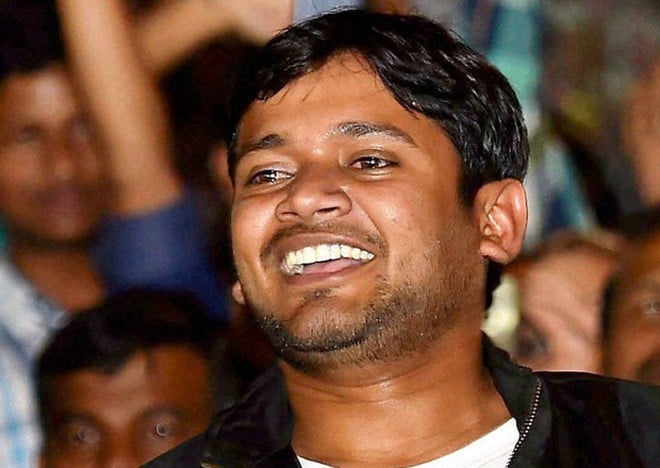
Understanding the Kanhaiya Kumar phenomenon

In Kanhaiya Kumar, the Indian polity has found an opposition leader who has the requisite potential to take on none other but Narendra Modi, the Indian premier. Through an electrifying speech at the JNU (Jawaharlal Nehru University) campus after his release from the prison on interim bail on March 2, Kumar has won substantial following among the general public, which is undoubtedly remarkable.
His speech exemplified his clarity of ideas and maturity in understanding the political situation. He successfully contested the election in 2015 as a candidate of the All India Student Federation, the student wing of the Communist Party of India.
To contextualise the particular disquiet engulfing the JNU, pertinent to mention here is that Kumar was arrested in February on the charge of sedition. He was alleged to have chanted anti-India slogans at the student rally, held against the hanging of Muhammad Afzal Guru in 2013, a Kashmiri separatist convicted over the attack on the Indian Parliament in 2001. After Kumar was released from jail, he dissociated himself from anything related to the hanging of Afzal Guru, which is widely believed to be a judicial murder. Later, in a press conference, he said, "Afzal Guru was sentenced by the court. There were controversies but I will not opine on that. For me, Afzal Guru was an Indian citizen. He was part of Kashmir, which is part of Akhand Bharat. For us Afzal Guru is not an icon, but Rohith Vemula is our icon. If you kill one Rohith Vemula, every household will bring up another Rohith".
As a consequence of shoving Afzal Guru’s uncalled-for hanging under the carpet, Kumar incurred a trenchant criticism from a few quarters. Nevertheless, his arrest and the countrywide response that it evoked catapulted Kumar from an elected president of the JNU’s student’s union to a nationwide political phenomenon.
Interesting as it may seem, Kumar has some parallels with the typical projection of Narendra Modi’s persona as someone who started from scratch but made himself into a phenomenal figure on the Indian political landscape. Modi boasts of his humble beginnings as a waiter at a small teashop in Ahmadabad from where he rose to be the prime minister of India. Kumar, a resident of the village of Bihar in Begusarai district, belongs to a family of meagre means with its earning of Rs3000 per month. His father Jaishanker Singh is bedridden for the last few years because of a severe stroke of paralysis, his mother, Meena Devi, is Anganwadi worker.
Despite such socio-economic handicaps, his ambitions, as betrayed from his speech, seem as big as presumably were once nursed by Modi. So, being young, fiery and furious, Kumar can be a formidable adversary to the one currently in the saddle. His place of origin could have had a profound rub on his political orientation. He hails from Bihar, where the Bharatiya Janata Party (BJP) could not secure even the slightest foothold.
It is pertinent to state here that Kanhaiya Kumar’s zeal for Marxism emanates from the fact that the Teghra constituency in which his village also falls has been "known to be a stronghold of the Communist Party of India (CPI)". Thus the political character of Biharis in general reflects nonchalance towards the BJP and also the ideals it stands for. Then he, as a JNU student leader, operates from Delhi where Arvind Kejriwal, despite BJP having been firmly ensconced at the centre, swept the polls. These facts might have contributed to the defiance manifested in the persona of Kanhaiya Kumar.
While saying so, one must not downplay the strong influence that the Left-Centric ideology wields at the JNU itself (established in 1969). It is important to note here that the university’s constitution has a strong leftist ring to it, largely because of a known Communist Party leader Prakash Karat who contributed exhaustively to it. Karat was once a student at the JNU. With the BJP coming into power, the JNU loyalists saw a lurking fear for the institution but more so for the ideology and ethos that it unequivocally espouses.
With this context in mind, one may aver that Kumar’s adversarial stance not only to the ideology but also to the practitioners and supporters of Hindutva held out hope and promise to many disgruntled souls. The invocation of Azadi (freedom) by Kumar and his bid to quite emphatically re-invent the Indian nationalism embedded in Marxist tradition needs to be looked at in detail though.
If one looks at it closely, there is an umbilical link between Azadi and the anti-imperial ideology mostly couched in Marxist ideology. Historically speaking, such phrases like Azadi, Suraaj etc. began to reverberate in the subcontinent immediately after the October Revolution in 1917. But the point pertaining to the connection between Azadi and anti-imperial ideology needs a separate, full-fledged study. In its current connotation, the slogan ‘Azadi’ is typical to the cause of Kashmiri Muslims.
Some of the Kashmiri activists among the Indian diaspora have taken strong exception to the appropriation of their slogan by Kumar. On top of it, he has dragged the slogan within the national frame by saying he does not want Azadi from India, rather he wants Azadi in India. The appropriation has caused a heart-burn among many who were expecting him to make some reference to Kashmir in his otherwise eulogised speech.
Equally important is the strategy that Indian Left has emphasised upon, where the hardcore leftist elements must include Dalits and Kashmiris to produce an alternative narrative to the prevailing Hindutva. The leftist with its traditional political tools would not be able to bounce back as a serious contender for power.